Test Score Calculator for Grade Percentage
Want to calculate your test grade percentage automatically? Try the free test score calculator below. Indicate the number of questions in a test, add the number of right or wrong answers, and enjoy the result.Take the following 3 steps to use the tool:
- Indicate the total number of questions in the test;
- Add the number of right or wrong answers;
- Get the test grade percentage.
🧮 How to Calculate Test Grade Percentage
Students often ask how to calculate test grade percentages without using specific tools. For this purpose, you’ll need to use a simple formula or download a handy chart to avoid calculations.
First, let’s start with the test grade percentage formula. You need to divide the number of correct answers by the total number of questions. Then, multiply by 100% to know the percentage grade.
Yep, that’s easy!
For example, if there were 97 questions and you answered right to 85 of them, the calculations are following:
1. 85 / 91 = 0,934
2. 0,934 * 100% = 93,4%
This way, you need only a calculator on your phone or a piece of paper.
Don’t trust your calculations?
Here’s a simple chart to use for your results’ determination:
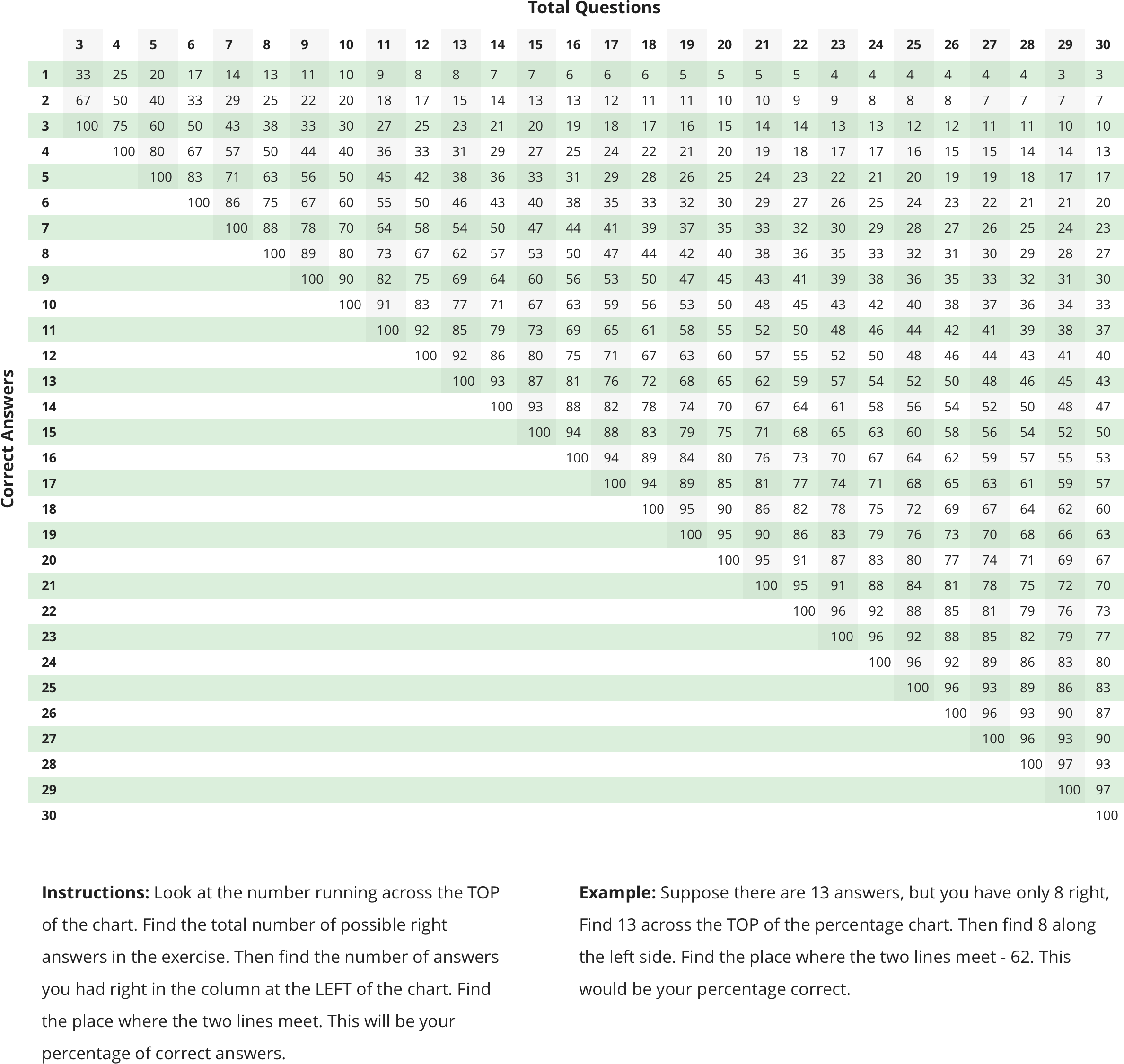
How to use it? Look at the top of the chart—here, you need to find your total number of questions. Then, point out how many answers were correct on the left part of the table. The place where the lines meet is your percentage result.
Save this chart or share it on social media to have it near any time!
Now you know how to find out your test grade without any calculators.
🎓 Why Are Test Scores Important?
An educational test is a tool that aims to assess a student's knowledge and skills in a specific subject or study field.
Tests are important in education because they are a simple means to measure one's understanding and mastery of the material being taught.
Tests can also indicate areas where a student may need additional support or instruction.
There are 4 various types of testing that teachers usually use.
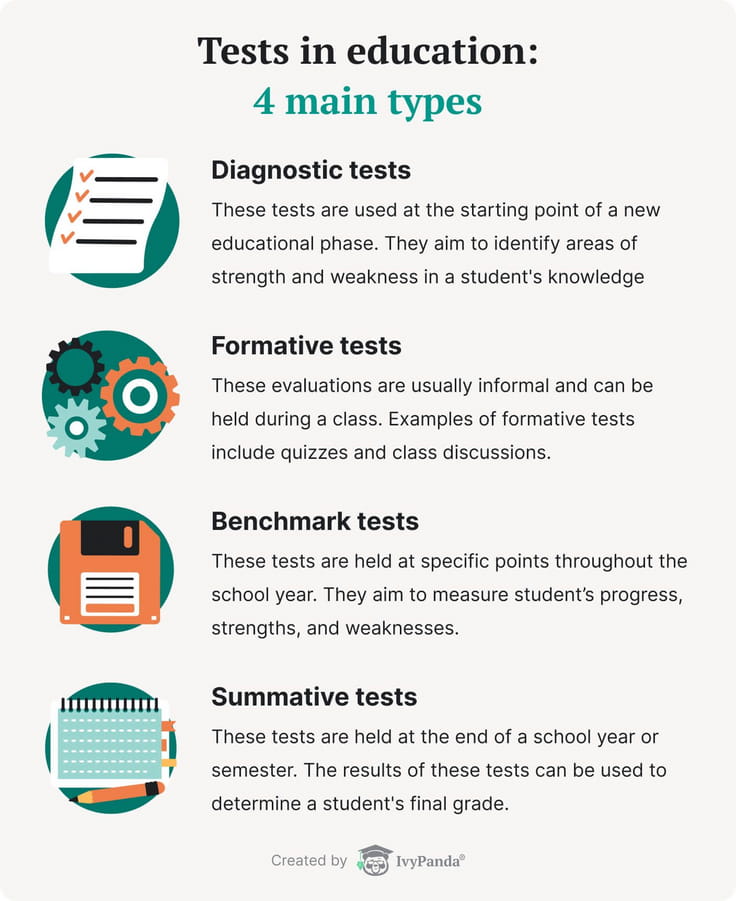
4 Main Types of Tests
📍 How to Get & Calculate a High Test Score
As a student, you may be terrified by SAT or ACT. You also face tests almost everywhere while studying at school or college, and that may stress you out. But there’s no need for worries if you’re well prepared! In this chapter, we responded to your request and gathered the best tips to help you pass any test.
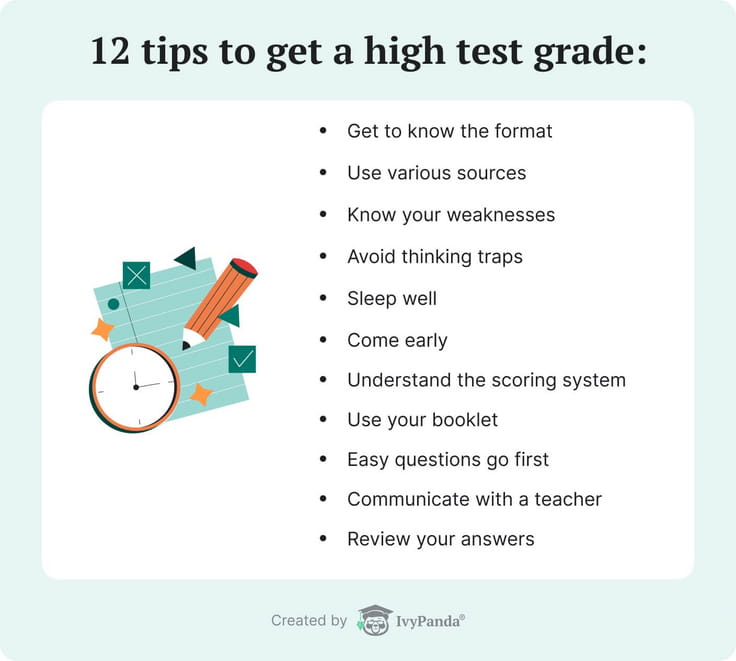
Tip #1 – Get to Know the Format
At the very beginning of your studies, learn everything about your test:
- What sections are there in the test?
- What types of questions you’ll have to answer?
- What tools and materials are you allowed to use during the test?
- How much time do you have in each section?
- What format should you stick to?
- Are there any textbooks that give a structured view of the test’s materials?
Only when those questions are clear and you’ve developed a strategy, it’s time to improve your knowledge of the subject.
Tip #2 – Use Various Sources
When preparing for a test, don’t focus on textbooks only, and don’t devote all your time to practicing tests online.
When remembering enormous volumes of information, use as many reliable sources as possible. It will structure the knowledge and help you to build connections between topics.
Watch online courses, do research, visit a library, listen to podcasts, ask a teacher to explain an issue that’s bothering you—all these methods are excellent when they’re drawn together.
Tip #3 – Know your Weaknesses
That’s something you should do long before the test—take care of your weak spots. Revise the materials and determine which topics you should understand better. Then, spend additional time on its examination.
It’s especially relatable for standardized language tests divided into several categories. For example, you may discover that listening is your weakness. In this case, devote more time to audio exercises.
Tip #4 – Avoid Thinking Traps
When you’re stressed out because of final exams or regular tests, it’s often challenging not to ask yourself anxious questions.
- What if the teacher doesn’t like you?
- What if your preparations weren’t as thorough as they might be?
- What would others think if you fail?
Stop thinking like this, and you’ll reduce the chance of getting into thinking traps. These are illogical thoughts you may have in a stressful situation. For example, fortune-telling when you’re trying to predict something when it’s scientifically impossible, and so on.
Tip #5 – Sleep Well
Healthy sleep is one of the most important things you can do to help yourself pass. While learning for finals, it helps you to remember more, avoid procrastination, and improve concentration. It’s also a significant tool to fight test anxiety and stay optimistic about your results.
You should also avoid all night studies, especially the night before the test. It’s significant to think clearly in the morning and achieve success during the exam.
Tip #6 - Come Early
It’s not only a tip to avoid being late in case your bus was delayed, or you didn’t remember where your keys are. It is also a psychological trick to give you some time to get used to a classroom and relax.
Determine all the distractions and try to fix them (like the lack of light in a class), then check all the tools you need for a test, and do breathing exercises to calm down.
Also, don’t forget to stay hydrated! You’ll definitely want to drink because of all the stress, so, make sure to take some.
Tip #7 – Understand the Scoring System
To boost your score, you should learn what the maximum score you can get for certain questions is. It can affect your performance when you distribute time to different sections.
Try to choose those questions first that are highly valued but still easy to answer. Can’t estimate the most difficult part? Then, notice that multiple-choice questions are not the most challenging type, so try to begin with them.
Tip #8 – Use Your Booklet
One of the significant questions you should ask your instructor about: “Can I write in my booklet?”
In most cases, you’re able to scratch and draw in this paper, and that plays a critical role in time-saving. Cross out wrong answers, write suggestions, fill in the fields, solve math puzzles, draw tables and diagrams, leave cues for future thinking, or highlight the answers you’re confident with.
Tip #9 – Search for Wrong Answers
A successful tactic that helps a lot in answering multiple-choice questions. According to statistics, you have more chances to guess the right question by crossing out only one wrong answer.
It also helps to structure information and apply logic. Imagine what a test creator was thinking about when making up this question and try to use this knowledge.
Tip #10 – Easy Questions Go First
If there is no specific answering order, answer simple questions first. Not only it affects your raw score and successful results (the more questions you answer in the beginning, the more time you have for solving challenging tasks), but a good pace also boosts your confidence.
The most important part:
Don’t get too excited and relaxed when you finish the half of the work. When you think you have a lot of time left, it’s usually an illusion, as you should solve the rest of questions, review all the work, and write down the answers in a right way.
Tip #11 – Communicate with a Teacher
The rules don’t allow you to talk with classmates during the test. But if a question is formulated poorly or it’s misleading and, due to this, has more than one answer, you can ask your teacher for clarification.
It’s especially important to draw teacher’s attention to the questions with misprints. Firstly, it would save you some time you would’ve spent on guessing the right instructions. And, secondly, it wouldn’t be helpful only for you but for all classmates, in general.
Tip #12 – Review Your Answers
Maybe you’re too nervous, not great in time distribution, had not enough sleep, not really attentive, or just tired. The reasons may be different, but they all lead to one result—everyone makes mistakes.
So, how to get rid of them? Easy.
Just leaving some time for re-reading the answers, you can earn a much higher grade. And we bet you don’t want to miss this chance!
🏆 Top-5 Test Grade Percentage Calculators
The test impact on grades can be huge, so it’s okay if you worry about its results.
In this chapter, you’ll find the best online calculators and guides to determine your test score in a minute.
1. Test Score Calculator by IvyPanda
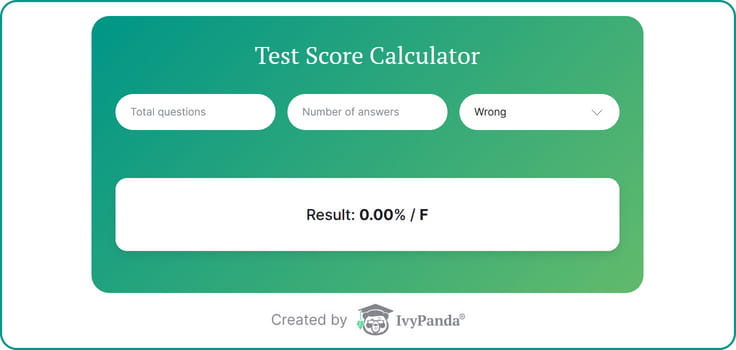
The new grade percentage calculator by IvyPanda is beautiful and very user-friendly.
The interface is quite simple. To calculate your test grade percentage, you’ll need to indicate the total number of questions in the test. Then you’ll have to choose the type of answers you’ll use to calculate the test score: right or wrong. After that, you should indicate the number of answers. The test grade percentage will be calculated automatically.
With this tool, you won’t need to download anything on your computer or mobile device. IvyPanda grade score calculator is 100% online, free, and doesn’t require any registrations.
2. Quick Grade Calculator

This is one of the easiest grade calculators for teachers you can find online. Of course, you can use it if you’re a student as well. It’s interactive and pleasant to use. Firstly, you enter the total number of questions, then the number of wrong answers.
If you find more mistakes, just click “+ 1 Wrong”, and the percentage updates automatically. If your final mark depends on the test, you can easily find out your chances to earn a satisfying grade right now.
As an option, you can open a chart to establish the final grade for the test. There’s also a choice to enable decimals.
3. Math Warehouse
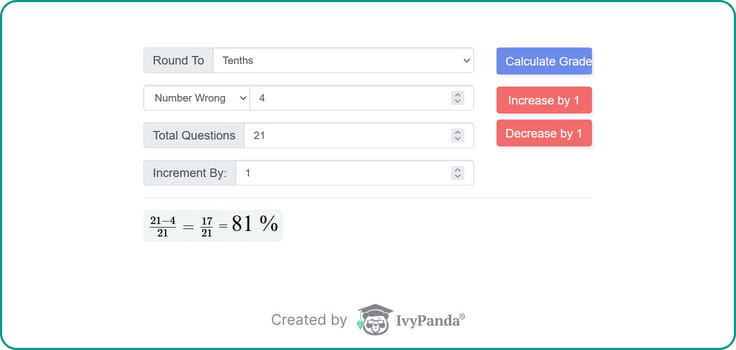
This is a test mark calculator that offers an enormous number of functions. In the beginning, you need to choose the format of results—should the service round it to tenths, hundredths, thousandths, etc. Then, fill in the fields about the test’s characteristics.
You can easily increase or decrease the result by clicking one of the buttons. You can also use “A” and “W” keys for the more convenient usage. Under the form, there’s the calculation itself. It’s presented as a formula that you can remember and use on your own.
Here you can also see the table of percentages where you can switch the order from “low to high” to “high to low”.
4. CSG Network.com
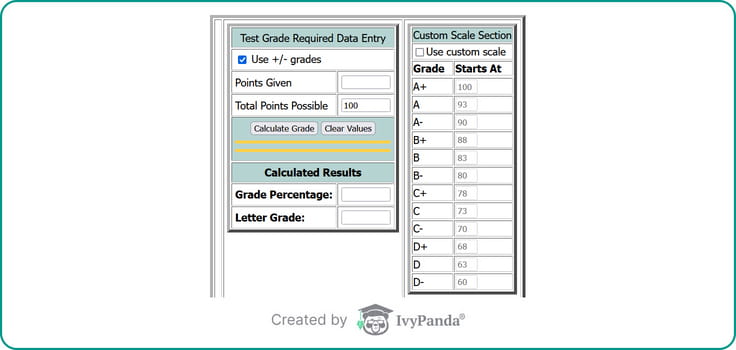
Another great tool to figure out your test grade. Whether you study at school, college or university, you may need to calculate it and to get the result quickly.
With this tool, not only you can calculate the formula, but also there’s a chart to answer the question “What is my grade?”. You can also use a custom scale where you are the one who determines every grade’s range.
It doesn’t matter if your professor uses 5-point or 12-point grades system, you can enable or disable +/- grades at any moment. The result is given both in percentage and letters.
5. RapidTables Calculator
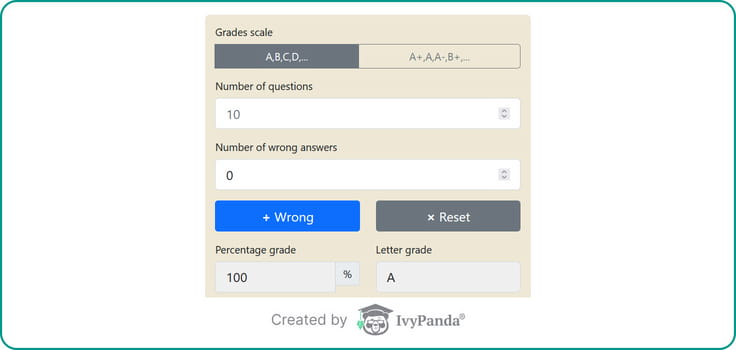
RapidTables grade score calculator is simple and intuitive. All you need to do to get the result is add the number of questions and the number of wrong answers.
The score will be counted automatically. It is given both as a letter grade a percentage. You can easily add a wrong answer or reset the tool. Note that there is a grade options table with the list of possible results.
📝 Test Score Generator: the Benefits
❓ Test Score Calculator FAQ
Updated: